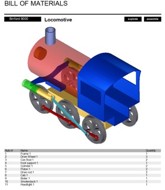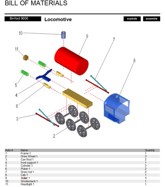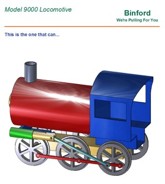
QuadriSpace Tells All!
Staff
General DPNThe word “design” comes from the same Latin root as “designate”, meaning to show to, to tell, to explain to others. If you have an idea and then build it yourself you are not a designer, you are an artisan or craftsman. You are not a designer until you can document your idea so others can implement it, but engineering drawings are not enough. Required documentation can include manufacturing specifications and instructions, sales literature, installation and operating manuals, servicing instructions, and repair manuals.
–
The problem is that many of the best designers are not the greatest writers, so many companies hire technical writers. This solution can create two new problems, however. One problem is that the best technical writers are not always the most proficient at using the CAD software in order to produce the graphics they need. The other problem is that it can be extremely difficult to justify the cost of extra CAD seats just to meet the occasional needs of the writing department.
Fortunately, QuadriSpace Corporation (www.quadrispace.com) has a solution, or several solutions to be more precise. Their Document3D Suite set of software products allow technical writers to directly access most common 2D and 3D CAD file formats without having to have the originating software installed. They are then able to quickly and easily generate illustrated manufacturing, sales, and service documents that include illustrations, exploded views, and parts lists from the CAD files. Formatted text descriptions and annotations can easily be added using a full range of word-processor functionality.
“Easy to Use” is Easy to Say…
I got a little nervous when I saw that QuadriSpace were touting their products as being as easy to install and use as Microsoft Office, because I will freely admit that Word is not one of my favourite programs. In fact, I dislike the ribbon menu in Word 2007 so much that I went back to Word 2003.
Actually, QuadriSpace are wrong. I found their products to be easier to use, and the ribbons more logical, than the Office family. For example, I did not take any classes nor did I work through one single tutorial. All I did was to browse their web page and parts of their “Getting Started” documentation so that I had an idea of what the software could do. After a couple of hours of experimenting and a couple of hits at the Help facility I was able to produce an illustrated parts list for an Inventor assembly.

Actually, it’s better than that. Once I had figured out how to do it I was able to produce the actual document in just a few seconds. All I needed to do was to use QuadriSpace Pages3D to start a new document from a suitable template. I was then automatically prompted to select an appropriate 3D CAD model, so I browsed to my Inventor assembly and selected it. That’s it. Period. Pages3D opened the Inventor model, inserted it into the page layout, and generated the bill of material table. Done.
Next, a couple of mouse clicks later and I had created an alternate exploded view. It then just took a few minutes to drag and drop the component parts to set up the exploded view the way I wanted it, and to add the tags. The tag numbers were automatically generated from the bill of material list.

Now comes the fun part. You can simply click on the “Explode” and “Assemble” buttons in the document to run an animation that shows how everything comes apart and goes together. In addition, you can zoom, pan, and orbit the model in either view and the anchor points of the tag numbers obediently stay correctly attached.
You can click on a part in the model to locate it in the bill of material and vise-versa, and you can suppress or unsuppress parts.
Okay, now it’s time to publish the document. Pages3D has several output modes available.
First, you can simply save it in QuadriSpace’s proprietary format. It can then be opened and manipulated by their free viewer, available from their web page at www.quadrispace.com.
Next, it can be saved in the ubiquitous PDF format. The widely-available free PDF viewer software, available to run on several different operating systems, can then open and manipulate it.
You can also publish it as a self-contained executable interactive file, or to an interactive CD, or to an interactive web page and if you get desperate, you can always print a hard copy.
Now that we have seen the basics, let’s look at a few of the details, starting with applications. QuadriSpace produce four primary products.
We have already seen Pages3D which is used to produce full documents. Publisher3D is used to create illustrations and animations, usyally for use in some other document. There is some overlap, in that Pages3D includes many of the graphics functionalities of Publisher3D. On the other hand, Publisher3D includes more output modes such as the common raster image formats, AVI animations, and Autodesk DWF files.
Next we come to Documents3D Suite, which combines the other two products.
Finally, there is the free viewer that I mentioned earlier.
The basic products support Inventor, SolidWorks, AutoCAD, Google SketchUp, 3DS, OBJ and several other common file formats while the optional Granite Import Module adds Pro/ENGINEER, STEP and IGES among others.
Let Me Count The Ways…
Now let’s look at how easy it is to get started. Pages3D comes with about 50 templates that cover a wide range of documentation needs. They are grouped by type, and include such categories as catalogs, brochures, instructions, engineering documentation, and presentations. Templates can easily be modified or you can create your own.
In addition, a series of themes can be applied to any document. Themes are basically sets of colours that are applied to the background, to body text, to headings, to tables, and so on. You can switch back and forth until you find a theme that suits your needs, or you can create custom ones.
As with the bill of materials document, it took less than two minutes to produce this sales brochure. Note the different lighting, shadows, and metallic reflections as compared to the bill of material illustrations, which use the generic Inventor appearance.

A single Pages3D document can consist of multiple pages that can contain several different assemblies and sub-assemblies as well as individual parts, but they are stand-alone single files that do not need the original CAD files to be present when you distribute them. Ah, but what if the original design changes? No problem. Simply open the file and re-insert the revised CAD models and everything automatically updates. This one feature alone can save hours, if not days, in the documentation process.
QuadriSpace emphasize that non-engineers can use their products to quickly produce product documentation without the need for engineer’s time or engineering software, but I feel that even an organization as small as a one-person consulting engineering firm could benefit from using it.
A free 15-day trial copy of Document3D Suite can be downloaded from www.quadrispace.com/downloads/index.htm
The problem is that many of the best designers are not the greatest writers, so many companies hire technical writers. This solution can create two new problems, however. One problem is that the best technical writers are not always the most proficient at using the CAD software in order to produce the graphics they need. The other problem is that it can be extremely difficult to justify the cost of extra CAD seats just to meet the occasional needs of the writing department.
Fortunately, QuadriSpace Corporation (www.quadrispace.com) has a solution, or several solutions to be more precise. Their Document3D Suite set of software products allow technical writers to directly access most common 2D and 3D CAD file formats without having to have the originating software installed. They are then able to quickly and easily generate illustrated manufacturing, sales, and service documents that include illustrations, exploded views, and parts lists from the CAD files. Formatted text descriptions and annotations can easily be added using a full range of word-processor functionality.
“Easy to Use” is Easy to Say…
I got a little nervous when I saw that QuadriSpace were touting their products as being as easy to install and use as Microsoft Office, because I will freely admit that Word is not one of my favourite programs. In fact, I dislike the ribbon menu in Word 2007 so much that I went back to Word 2003.
Actually, QuadriSpace are wrong. I found their products to be easier to use, and the ribbons more logical, than the Office family. For example, I did not take any classes nor did I work through one single tutorial. All I did was to browse their web page and parts of their “Getting Started” documentation so that I had an idea of what the software could do. After a couple of hours of experimenting and a couple of hits at the Help facility I was able to produce an illustrated parts list for an Inventor assembly.

Actually, it’s better than that. Once I had figured out how to do it I was able to produce the actual document in just a few seconds. All I needed to do was to use QuadriSpace Pages3D to start a new document from a suitable template. I was then automatically prompted to select an appropriate 3D CAD model, so I browsed to my Inventor assembly and selected it. That’s it. Period. Pages3D opened the Inventor model, inserted it into the page layout, and generated the bill of material table. Done.
Next, a couple of mouse clicks later and I had created an alternate exploded view. It then just took a few minutes to drag and drop the component parts to set up the exploded view the way I wanted it, and to add the tags. The tag numbers were automatically generated from the bill of material list.

Now comes the fun part. You can simply click on the “Explode” and “Assemble” buttons in the document to run an animation that shows how everything comes apart and goes together. In addition, you can zoom, pan, and orbit the model in either view and the anchor points of the tag numbers obediently stay correctly attached.
You can click on a part in the model to locate it in the bill of material and vise-versa, and you can suppress or unsuppress parts.
Okay, now it’s time to publish the document. Pages3D has several output modes available.
First, you can simply save it in QuadriSpace’s proprietary format. It can then be opened and manipulated by their free viewer, available from their web page at www.quadrispace.com.
Next, it can be saved in the ubiquitous PDF format. The widely-available free PDF viewer software, available to run on several different operating systems, can then open and manipulate it.
You can also publish it as a self-contained executable interactive file, or to an interactive CD, or to an interactive web page and if you get desperate, you can always print a hard copy.
Now that we have seen the basics, let’s look at a few of the details, starting with applications. QuadriSpace produce four primary products.
We have already seen Pages3D which is used to produce full documents. Publisher3D is used to create illustrations and animations, usyally for use in some other document. There is some overlap, in that Pages3D includes many of the graphics functionalities of Publisher3D. On the other hand, Publisher3D includes more output modes such as the common raster image formats, AVI animations, and Autodesk DWF files.
Next we come to Documents3D Suite, which combines the other two products.
Finally, there is the free viewer that I mentioned earlier.
The basic products support Inventor, SolidWorks, AutoCAD, Google SketchUp, 3DS, OBJ and several other common file formats while the optional Granite Import Module adds Pro/ENGINEER, STEP and IGES among others.
Let Me Count The Ways…
Now let’s look at how easy it is to get started. Pages3D comes with about 50 templates that cover a wide range of documentation needs. They are grouped by type, and include such categories as catalogs, brochures, instructions, engineering documentation, and presentations. Templates can easily be modified or you can create your own.
In addition, a series of themes can be applied to any document. Themes are basically sets of colours that are applied to the background, to body text, to headings, to tables, and so on. You can switch back and forth until you find a theme that suits your needs, or you can create custom ones.
As with the bill of materials document, it took less than two minutes to produce this sales brochure. Note the different lighting, shadows, and metallic reflections as compared to the bill of material illustrations, which use the generic Inventor appearance.

A single Pages3D document can consist of multiple pages that can contain several different assemblies and sub-assemblies as well as individual parts, but they are stand-alone single files that do not need the original CAD files to be present when you distribute them. Ah, but what if the original design changes? No problem. Simply open the file and re-insert the revised CAD models and everything automatically updates. This one feature alone can save hours, if not days, in the documentation process.
QuadriSpace emphasize that non-engineers can use their products to quickly produce product documentation without the need for engineer’s time or engineering software, but I feel that even an organization as small as a one-person consulting engineering firm could benefit from using it.
A free 15-day trial copy of Document3D Suite can be downloaded from www.quadrispace.com/downloads/index.htm
Bill Fane (bill_fane@bcit.ca ) is an independent software reviewer and retired mechanical engineering instructor at the British Columbia Institute of Technology.
Advertisement
Stories continue below
